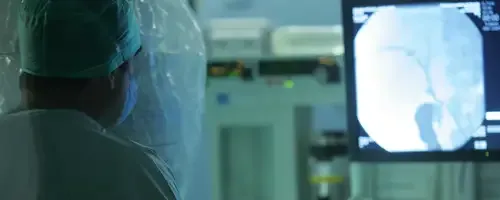Vascular malformations
"Sclerotherapy in microfoam is especially indicated in venous vascular malformations and in mixed ones of predominantly venous or low flow".
DR. ALEJANDRO SIERRA
PERSON IN CHARGE. PHLEBOLOGY AREA

Vascular malformations are benign (non-cancerous) lesions, always present from birth, but sometimes not visible until weeks or months later.
The incidence is the same in women as in men.
Depending on whether the vascular malformation is arterial or venous, the implications can vary and the complications presented by the patient can be simply aesthetic or cause a major health problem.

What are the symptoms of vascular malformations?
Vascular malformations will cause symptoms depending on their severity and vascular involvement.
It can manifest itself as a spot on the skin that increases during the child's growth and later stabilizes.
If the vascular malformation is very large or affects important organs, it can compromise the quality of life of patients, increasing the risk of bleeding or even affecting the functionality of the compromised organ.
The most common symptoms are:
- Red-violet spots on the skin.
- Risk of bleeding.
Do you have any of these symptoms?
You may have a vascular malformation
How are vascular malformations diagnosed?

The diagnosis of vascular malformations is fundamentally clinical, based on a correct anamnesis and a thorough physical examination. The first thing is to know if the lesion is congenital and of very slow growth.
In the case of doubtful lesions, a biopsy with immunohistochemistry for the antibody GLUT-1, specific for hemangiomas, is indicated.
Among the imaging tests, the first choice is usually the Doppler ultrasound, which makes it possible to differentiate whether the lesion is high or low flow and to distinguish whether it is a hemangioma or a vascular malformation.
Depending on the type of lesion, location and degree of affectation it may be necessary to perform an X-ray, MRI, phlebography, angio-resonance, arteriography or lymphoscintigraphy to complete the study.
How are vascular malformations treated?
Vascular malformations should be treated as much as possible, taking into account the type of injury, location and depth.
Small and superficial lesions can usually be treated with laser with almost total improvement.
In extensive and deep lesions the treatment is complex, being practically impossible to eradicate in most cases.
Sclerotherapy consists of the injection of a liquid chemical product inside a blood vessel, so that when it contacts the vessel walls (the endothelial cells) it produces its occlusion or collapse.
These vessels can be of different sizes, from telangiectasias or small caliber venules, to varicose veins or large phlebectasias.
The effectiveness of sclerosis depends on the diameter or caliber of the vessel and blood flow. The greater the caliber or the greater the flow, the greater the difficulty of contact between the sclerosant and the endothelial cells of the vascular wall, and therefore the lesser the efficacy.
Where do we treat it?
IN NAVARRE AND MADRID
The Vascular Surgery Service
of the Clínica Universidad de Navarra
The Vascular Surgery Service of the Clinic has the latest technology for the diagnosis, treatment and surgery of vascular pathologies. Our wide experience, framed in the quality care environment of the University of Navarra Clinic, allows us to offer the patient the most effective and innovative treatments.
We have an operating room specialized in vascular surgery, equipped with advanced equipment for the surgical treatment of the most important vascular diseases.
We are pioneers in endovascular brachytherapy, localized radiotherapy to treat tumors, which has been practiced in the world on very few occasions.
Diseases we treat
- Diseases of the aorta
- Carotid diseases
- Chronic venous insufficiency (varicose veins)
- Ischemia of lower extremities
- Varicose ulcers

Why at the Clinica?
- En menos de 24 horas podemos realizar las pruebas necesarias para establecer el diagnóstico y el planteamiento del tratamiento.
- Área de Flebología pionera en España en el tratamiento de varices con microespuma.



